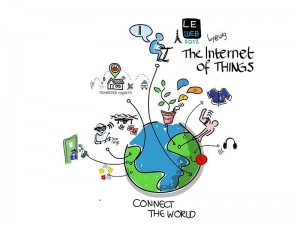‘The first industrial revolution mobilised the mechanization of production using water and steam power. The second industrial revolution then introduced mass production with the help of electric power, followed by the digital revolution and the use of electronics and IT to further automate production.’ Now we are about to catch the next big wave of change; Industry 4.0 .
Here is a video of what networked factories of tomorrow will look like:Video. Imagine networked intelligent cyber physical systems operating in all aspects of our urban environment. The Internet of Things is coming to a city near you.
The way of the future is computerization and further automation with global collaboration using the Internet of Things (IoT) to drive innovation and change in factories that are no longer constrained by time and space. ‘British entrepreneurKevin Ashton first coined the term in 1999 while working at Auto-ID Labs (originally called Auto-ID centers – referring to a global network of Radio-frequency identification(RFID) connected objects).Typically, IoT is expected to offer advanced connectivity of devices, systems, and services that goes beyondmachine-to-machine communications (M2M) and covers a variety of protocols, domains, and applications.The interconnection of these embedded devices (including smart objects), is expected to usher in automation in nearly all fields, while also enabling advanced applications like a Smart Grid, and expanding to the areas such as smart cities.’ See Internet of Things for Smart Cities
Germany has since 2011 been leading the way in conceptualizing and delivering the future of integrated smart manufacturing. Industry 4.0 is an ‘invention’ of the German Government pro-actively championing Germany’s competitive advantage in manufacturing excellence. ‘There are six design principles in Industry 4.0. These principles support companies in identifying and implementing Industry 4.0 scenarios:
Interoperability: the ability of cyber-physical systems (i.e. workpiece carriers, assembly stations and products), humans and Smart Factories to connect and communicate with each other via the Internet of Things and the Internet of Services
Virtualization: a virtual copy of the Smart Factory which is created by linking sensor data (from monitoring physical processes) with virtual plant models and simulation models
Decentralization: the ability of cyber-physical systems within Smart Factories to make decisions on their own
Real-Time Capability: the capability to collect and analyse data and provide the derived insights immediately
Service Orientation: offering of services (of cyber-physical systems, humans or Smart Factories) via the Internet of Services
Modularity: flexible adaptation of Smart Factories to changing requirements by replacing or expanding individual modules ‘
See Industry 4.0

If I were a betting man, I would be placing some investment funds into data storage and cross data platforms that aggregate data from heterogeneous end systems for the development of smart digital services in government and manufacturing.
Perhaps our current PM may want to take a leaf out of the German’s book here and think about integrating technology and manufacturing to deliver jobs as well as IP future for Australia. To do this well, Australia will need an Industry 4.0 ‘Tzar’ to coalesce policy from all three levels of government and integrate forward planning with entrepreneurs and industry.
It has been pinioned that the greatest obstacle to smart cities that use Industry 4.0 and the IoT is the ‘attribution of decision making power to various stakeholders. Surely politicians are good at this.
I remember some years ago a lot of talk about MFP’s (Multi Functional Polis) in Adelaide. Now it’s time to dust off such ideas with the advent of IoT and Industry 4.0 in an Australian context of a smart workforce, resource rich on the Pacific Rim of manufacturing growth and burgeoning markets. If so, we can use Australian human capital to prime the pump for mass technological leap into the future on this side of the globe (to outrun cities already experimenting with the smart city concept like Seoul) to match the Germans. Time to start thinking about an Industry 4.0 task force. Who should go onto such a body? People like Chris Vains, Head of Siemens Automation Systems Australia & NZ perhaps. Vains said ” We are talking about cyber-physical systems and the joining of the virtual on-line world and the physical, which might be manufacturing for example.” See article
One can see that the Industry 4.0 future will also align with Australia’s goals for limiting greenhouse gas emissions by being able to integrate manufacturing processes and the products they produce to have embedded objects that can feed data into control systems for more positive environmental outcomes. Rather than Carbon tax, one can imagine a future of tax credits (‘environmental franking credits’) being applied to products, processes and corporations that run them because there will be easily reportable metrics to measure compliance with Australian goals and standards.
An integrated whole of government and industry approach to building Industry 4.0 may well result in ‘Industrial Sustainability 5.0’ and deliver jobs to Australians as we build the Smart Country.
DO YOU WANT TO USE THIS ARTICLE IN YOUR NEWSLETTER OR WEBSITE?
You can, as long as you include the following text in its entirety:
Corporate First Lawyers provide affordable professional legal services to small, medium, and large size businesses in Australia, the United Kingdom and internationally. Headed by Peter Janssen BA.LLB.FAIM, Corporate first specialise in dispute resolution, commercial litigation, business succession planning, mergers, acquisitions, trademarks, copyright, IP and corporate advisory tasks.
